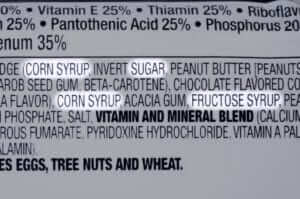As much as we try to take the natural, most holistic approach with our patients at CentreSpringMD, sometimes over the counter medications are needed. Did you know that the majority of OTC medications are loaded with food dyes, chemicals and preservatives that may be affecting our children? In fact, recent studies label these chemicals as excitotoxins, or chemicals that affect the delicate balance of neurotransmitters in the brain. The amount of food dyes and chemicals used in our children has increased over 500% in the last 50 years(1).
Food Dyes
Just about every children’s over the counter (and prescription) medication contains food dye(s), and there’s just no good reason for it. Food dyes have been associated with hyperactivity in children, especially children who already suffer from ADHD symptoms. The European Union (EU) requires that foods containing artificial food dyes have a warning on the label stating that the color “may have an adverse effect on activity and attention in children.” Most studies have included multiple food dyes (not just one color), so it’s unclear if there is one specific dye that is worse than others. Since food dyes add nothing to the efficacy of the actual medication, they are a completely unnecessary additive. You can usually identify them by looking for the names of different colors on the ingredients list, such as “FD&C red no. 40,” or “FD&C blue no. 1.” If you see these in the ingredients, put it back on the shelf and look for a dye-free choice instead(2).
For a complete list of dyes used in over the counter medications, check out this list.
Artificial Flavors
I get that medicine needs to taste good for a child to voluntarily take it, but that can be accomplished with natural flavors. Most OTC liquid or chewable medicines contain artificial flavors, which are chemicals that our bodies don’t recognize or know what to do with. They are proprietary chemical formulas – which means that the names or ingredients of these “flavors” do not need to be disclosed on the label. Even “natural flavors” can technically contain synthetic ingredients like chemical solvents. Opt for naturally-flavored OTC meds whenever possible by looking for the actual flavor (e.g. cherry extract or grape juice) rather than the term “natural flavor.”
Corn syrup or high fructose corn syrup (HFCS)

Children’s OTC medicines are almost always sweetened with some sort of sugar. We know sugar worsens inflammation, which is the opposite of what you want when your little one is sick. Corn syrup or HFCS is especially harmful because it causes the most dramatic insulin surge and leads to fatty deposition in the liver over the long term. It’s cheap, and super sweet, so it’s a popular choice for manufacturers. Not that any sugar is good for you, but you may want to opt for OTC meds that are sweetened with cane sugar, cane syrup, or even honey if your child is over 12 months old.
Artificial sweeteners
Right up there with corn syrup are artificial sweeteners. There are 5 artificial sweeteners on the market in the US: saccharin, acesulfame, aspartame, neotame, and sucralose. We are still discovering the dangers of these sweeteners to our brains and bodies. Aspartame is potentially neurotoxic – it breaks down into phenylalanine (which causes dopamine and serotonin to decrease, and potentially increases risk of seizures), aspartic acid (which is excitotoxic to neurologic cells, leading to their degeneration), and methanol (which is a known poison that can cause blindness in high enough doses). Other artificial sweeteners are problematic as well, so your best bet is to opt for one that is sweetened with real sugar sources like cane sugar.
Wheat/Gluten
Not everyone has to avoid gluten, but if your child has Celiac disease, or is sensitive or allergic to gluten, you’ll need to make sure there’s no gluten in their OTC meds. Starch is commonly added to medications, and this can be starch derived from wheat or from other sources. Make sure to read the “inactive ingredients” section to look for wheat or wheat starch. If the label says it’s gluten-free, you should be fairly confident that it’s safe. For celiac disease, cross contamination can be a concern, so when in doubt, call the manufacturer and ask.
Other allergens like dairy or corn
If your child has other food allergies or sensitivities, make sure to read the inactive ingredients for presence of those ingredients. A really common ingredient in OTC medicines is corn – this is usually in the form of cornstarch and/or corn syrup, but can include ingredients like dextrin, maltodextrin, and “modified food starch.” If in doubt, call the manufacturer.
This sounds like an impossible list but really it isn’t. There are some companies that are actually mindful of these ingredients and either make it easy for you with transparent labeling (it may say right on the front of the box: “dye-free, no artificial flavors or sweeteners, gluten-free,” etc.), or they make it clear on the ingredients list what the sources are (“modified food starch – not derived from wheat or corn;” or it will just say “potato starch” instead of “food starch”). Once you become a label detective, it’s hard to go back to giving your child the purple stuff!
